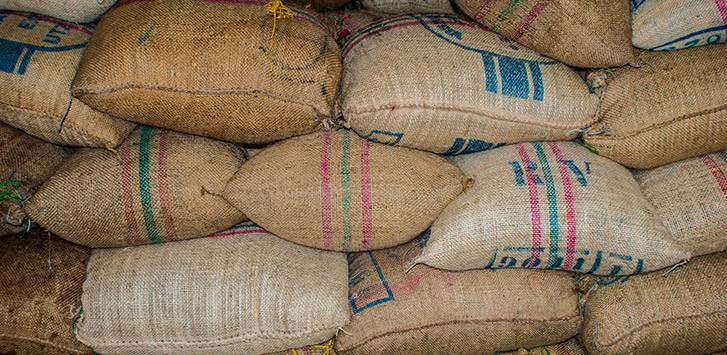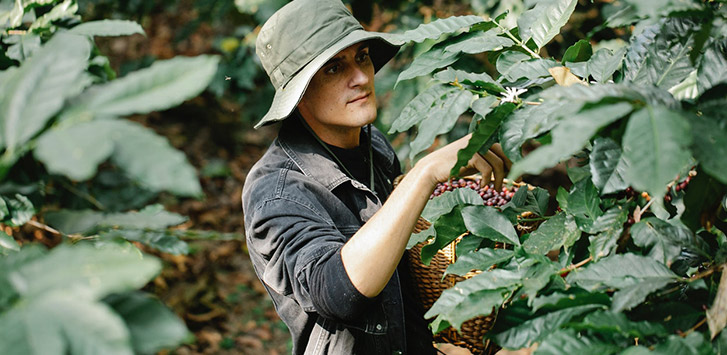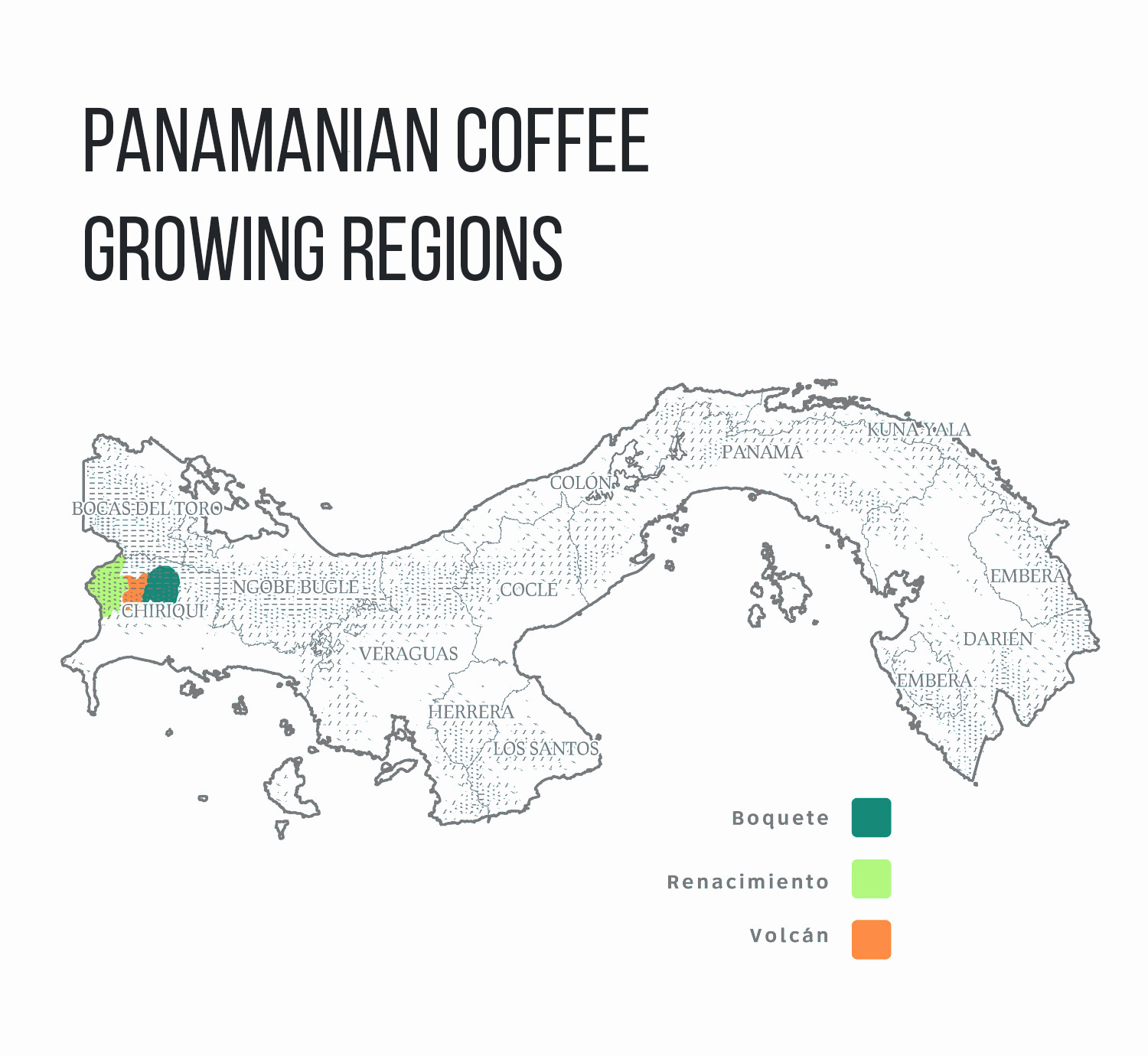
Panama might not be the largest coffee exporter in the world, but it’s home to the most expensive, highest quality single-origin coffee that entices every coffee connoisseur – the Geisha varietal. Over the past few decades, Panama transformed its mindset surrounding its coffee industry, deciding to pursue quality over quantity. If you buy Panamanian coffee, you can tell their heart is in their coffee beans!
History
The history of the Panama coffee production and industry begins in the mid-1700s when the coffee beans arrived in Portobelo from the French Caribbean. In 1780, settler Pedro Antonio de Ayarza registered coffee as an official crop and attempted to plant it in Portobelo. The crop ended up failing badly between the 1780s-1790s, but by 1810, farmers had found the right microclimates for it to grow.

Jumping ahead to 1997, the Specialty Coffee Association of Panama (SCAP) was founded, finally advancing the Panama coffee industry. SCAP turned the focus of the coffee industry on its head, moving from quantity to quality, and discovering one of the most expensive, high-quality Panama coffee beans in the process.
The Best of Panama (BOP) competition started in 1998, creating greater exposure for Panamanian coffee producers. In 2001, Panama hosted the first international, online auction of its coffee beans. Within the next decade, Panama had made a name for itself by breaking the triple-digit barrier with Hacienda La Esmerelda’s Geisha coffee bean, selling for $130.
In 2017, the Lamastus Family Estates broke the new record with their Geisha varietal, selling for $803, and then, again, in 2019 for $1,029. The final record was set by Finca Sophia, in 2020, at a total of $1,300.50.
The Panama coffee industry has experienced incredible growth over the past couple of decades, moving into specialty coffee and making a name for itself with the Panama Geisha coffee that’s completely irreplicable.
Growing Regions

Panama is an equatorial country located on the “bean belt”. It boasts numerous microclimates that are perfect for growing and cultivating complex and brightly acidic green coffee beans. Around 80% of Panama coffee is Arabica, while 20% is Robusta. The Robusta coffee beans are grown in the low altitude regions of Panama, while the Arabica coffee beans are grown in the mountainous and volcanic soil-blessed regions of the Chiriqui province.
The three main growing regions in the Chiriqui province are Boquete, Tierras Altas, Renacimiento and Volcan Baru (situated alongside the border of Chiriqui). Volcan Baru contains an active volcano, so each growing region has nutrient-rich soil perfect for growing a crop of coffee beans. Each region is also blessed by good transport and stable processing infrastructure, making it much easier to grow, process, and export the beans.
Boquete
Boquete is the oldest and best-known region in Panama. The coffee industry began in the 20th century here and has been going strong ever since, cultivating some of the best quality coffee in the world. Coffee from Boquete has a fruity taste and is medium-bodied, yet complex with spicy notes making for a delicious cup of coffee.
Volcan Baru
Volcan Baru is located on the steep, southwestern slopes of Volcan Baru. It’s here that the Geisha varietal is most prevalently grown. The rich soils and high elevations form near-perfect growing conditions for the world-famous coffee varietal.
Renacimiento
Renacimiento is the least well-known growing region because it’s so remote. Its crops are also nourished by the active volcano.
Cultivation
Panama has many different varieties of coffee: Cataui, Caturra, Maragogype, Pacamara, Mundo Novo, and the Geisha varietal. The two most common varietals are the Pacamara varietal and the Geisha varietal.
Pacamara
The Pacamara varietal is deemed high quality by SCAP. It’s a crossbreed of the Pacas and Maragogype varietals. Luckily, this coffee plant can tolerate rough climate conditions, consisting of strong winds, sunlight, and scarce water, and still produce a high yield. The Pacamara varietal is characterized by a light acidity with sweet notes of butterscotch and cacao and fruity tones of citrus and berries.
Geisha
The Geisha (sometimes called Gesha) coffee bean, as mentioned earlier, is world-famous. The coffee beans are grown at a high altitude, handpicked, and dried for 8 days before being sold green. Geisha coffee originated in the Gori Gesha forest in Ethiopia. It was discovered by British colonial voyagers in the 1930s and brought to research stations in Kenya and Tanzania before being exported to Panama.
Panama truly became acquainted with the Geisha varietal through the work of Francisco Serracin, owner of the Don Pachi Estate and founder of the Special Program at Panama’s Ministry of Agricultural Development. He spent time with the Tropical Agricultural Research and Higher Education Center (CATIE) in Costa Rica where he familiarized himself with the Geisha. In 2004, Geisha coffee was rediscovered when it gained world fame by winning first place at BOP for $21 per lb.
Geisha coffee is known for its bright acidity and sweet, fruity, yet floral, aroma that resembles jasmine and peach. Depending on where the coffee beans are grown, they can have many different flavor nuances. Some of the most common are a fruit-like zest with tangs of berry, peach, mango, guava, citrus, lime, jasmine, and pineapple. The differing flavor profile is one of the reasons that Geisha coffee is so popular.
The harvesting process is relatively difficult for Geisha beans. Farmers have to handpick the ripest cherries, which take years to fully ripen, and then process them with the washed method, the natural method, or the semi-washed method.
Nowadays, some of the major producers of the Geisha varietal are the Lamastus family, Hacienda La Esmerelda, Agricola, Maya, and PVA Coffee Farm.
Over the years, Panama has won numerous awards for its coffee as the country makes great leaps in cultivating complex and delightful coffee beans. The mix of workers, both young and old, combine a youthful willingness to try new things with the aged wisdom of what works best.
Roasting Suggestions
Geisha coffee is one of the hardest coffees to roast because of its incredible value. To fully experience the tastes and flavors that Panama coffee has to offer, you should stop roasting after the first crack, maintaining the quality of the bean and the oil.
Brewing Methods
Similar to roasting, you have to brew the grounds carefully and with an attentive eye. Only use filtered water when brewing to keep the full taste intact, and only use filtered brewing methods, like a drip brew or pour-over, to brew coffee grown in Panama.
The beans don’t do well enough with a darker roast, so espresso and other brewing methods that involve darker roasted coffee beans aren’t good options. In general, people drink this coffee black with no added milk, sugar, or cream to keep the taste pure. While this is a choice of preferences, it’s well worth it to try this coffee by itself and experience the fullness of its flavors.
Conclusion
In terms of coffee, Panama has a lot to offer! If you’re ever in the area or feel like splurging on a coffee, you should give the Geisha coffee a try and simply soak in all it has to offer.